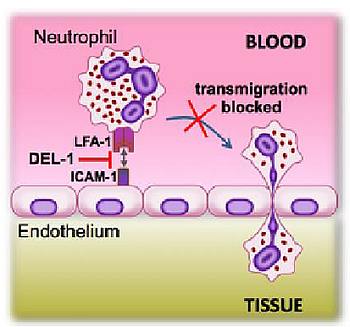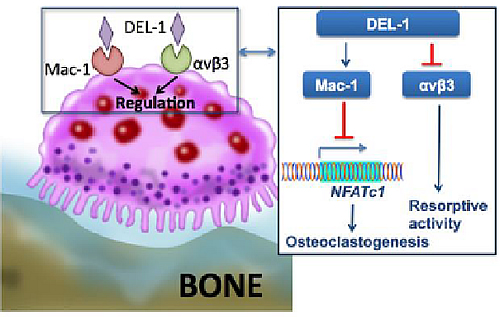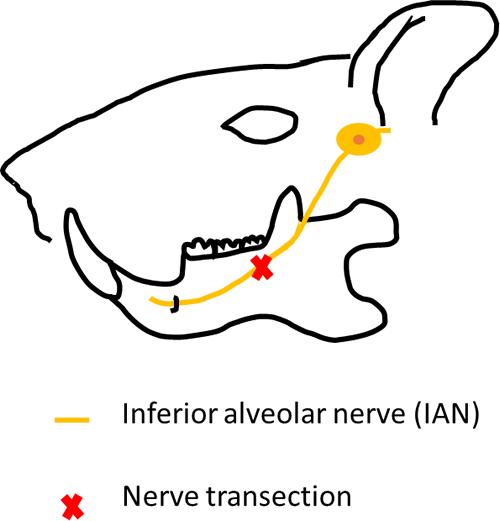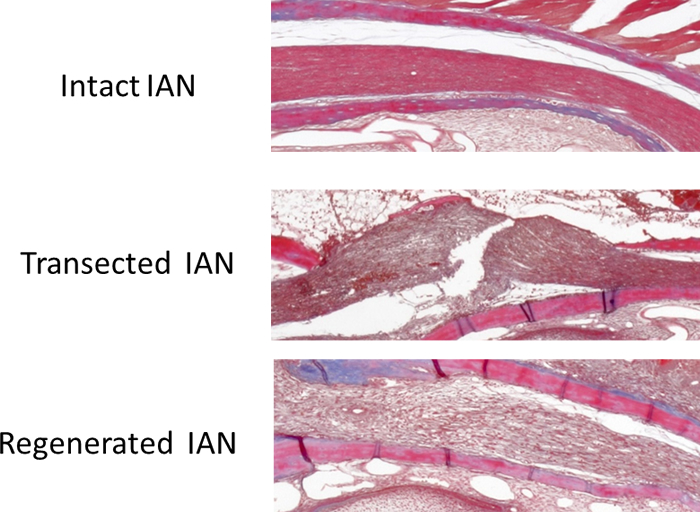Research
Regulatory mechanisms of homeostatic factor Del-1 in the inflammatory response.
The dissection of signalling pathways regulating Del-1 expression provides potential targets to treat inflammatory diseases and inflammatory bone loss.
Related publications)
- Maekawa T, Hosur K, Abe T et al. (2015) Antagonistic effects of IL-17 and D-resolvins on endothelial Del-1 expression through a GSK-3β-C/EBPβ pathway. Nature Commun.6:8272
- *Shin J, *Maekawa T, Abe et al. (2015) Del-1 restrains osteoclastogenesis and inhibits inflammatory bone loss in nonhuman primates. Science Transl Med. 7(307:307ra155
Interactions between the nervous system and immune responses in periodontal disease.
Transient receptor potential (TRP) channels are a family of cation channels that play a key role in a number of diseases. We are exploring the involvement of TRP channels in the pathogenesis of periodontal disease.
Related publications)
- Takahashi N, Matsuda Y, Sato K et al. (2016) Neuronal TRPV1 activation regulates alveolar bone resorption by suppressing osteoclastogenesis via CGRP. Sci Rep. 6:29294
- de Jong PR, Takahashi N, Harris AR et al (2014). Ion channel TRPV1-dependent activation of PTP1B suppresses EGFR-associated intestinal tumorigenesis. J Clin Invest. 124(9):3793-806

Application of oral mucosal oxygen biology for regenerative medicine.
Stem/progenitor cells reside hypoxic microenvironment in vivo. We aim to enhance the quality of an “Ex Vivo Produced Oral Mucosa Equivalent (EVPOME)” by mimicking in vivo oral mucosal oxygen microenvironment during the process of EVPOME fabrication to maintain the stemness of oral mucosa keratinocyte progenitors.
Related publications)
- Kato H, Marcelo CL, Washington JB et al. (2015) Fabrication of Large Size Ex Vivo Produced Oral Mucosal Equivalents for Clinical Application. Tissue Eng Part C. 21(9):872-80
- Kato H, Izumi K, Uenoyama A et al. (2014) Hypoxia induces undifferentiated phenotype of oral keratinocytes in vitro. Cells Tissues Organs. 199(5-6):393-404

Molecular and cellular biological studies of transcriptional networks regulating development of craniofacial organs such as teeth.
Because of the complexity and potential vulnerability of the region, most of congenital abnormality affect the craniofacial complex. We aim to reveal transcriptional networks regulating development of craniofacial organs with investigating the congenital craniofacial abnormality in the conditional knockout mice.
Related publications)
- Kawasaki K, Kawasaki M, Watanabe M et al. (2015) Expression of Sox genes in tooth development. Int J Dev Biol. 59:471-8
- Blackburn J, Kawasaki K, Porntaveetus T et al. (2015) Excess NF-κB induces ectopic odontogenesis in embryonic incisor epithelium. J Dent Res 94:121-8

Morphological research on sensory mechanism in orofacial region.
Tooth is an analogue to skin from the developmental aspect. Teeth have abundant sensory receptors which can perceive delicate sensation just like skin. Sensation in teeth is largely divided into pulpal and periodontal sensation.
By use of morphological techniques including immunohistochemistry and electron microscopy, we investigate the morphology of sensory receptors and their development/regeneration process.
Related publications)
- Maeda T, Ochi K, Nakakura-Ohshima K, et al. (1999) The Ruffini ending as the primary mechanoreceptor in the periodontal ligament: its morphology, cytochemical features, regeneration, and development. Crit Rev Oral Biol Med. 10(3):307-27
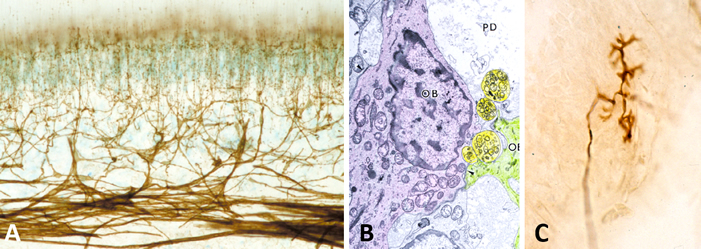
A: Pulpal nerved in human tooth (p75NGFR staining), B: Pulpal endings near odontoblasts (OB),
C: Periodontal Ruffini ending
Research on neuroplasticity in oro-facial region.
Dental treatment can cause injury of inferior alveolar nerve (IAN). The patient has poor prognosis, and there is no fundamental treatment. We aim to clarify the pathology and regeneration mechanism of IAN using IAN injury animal model.

